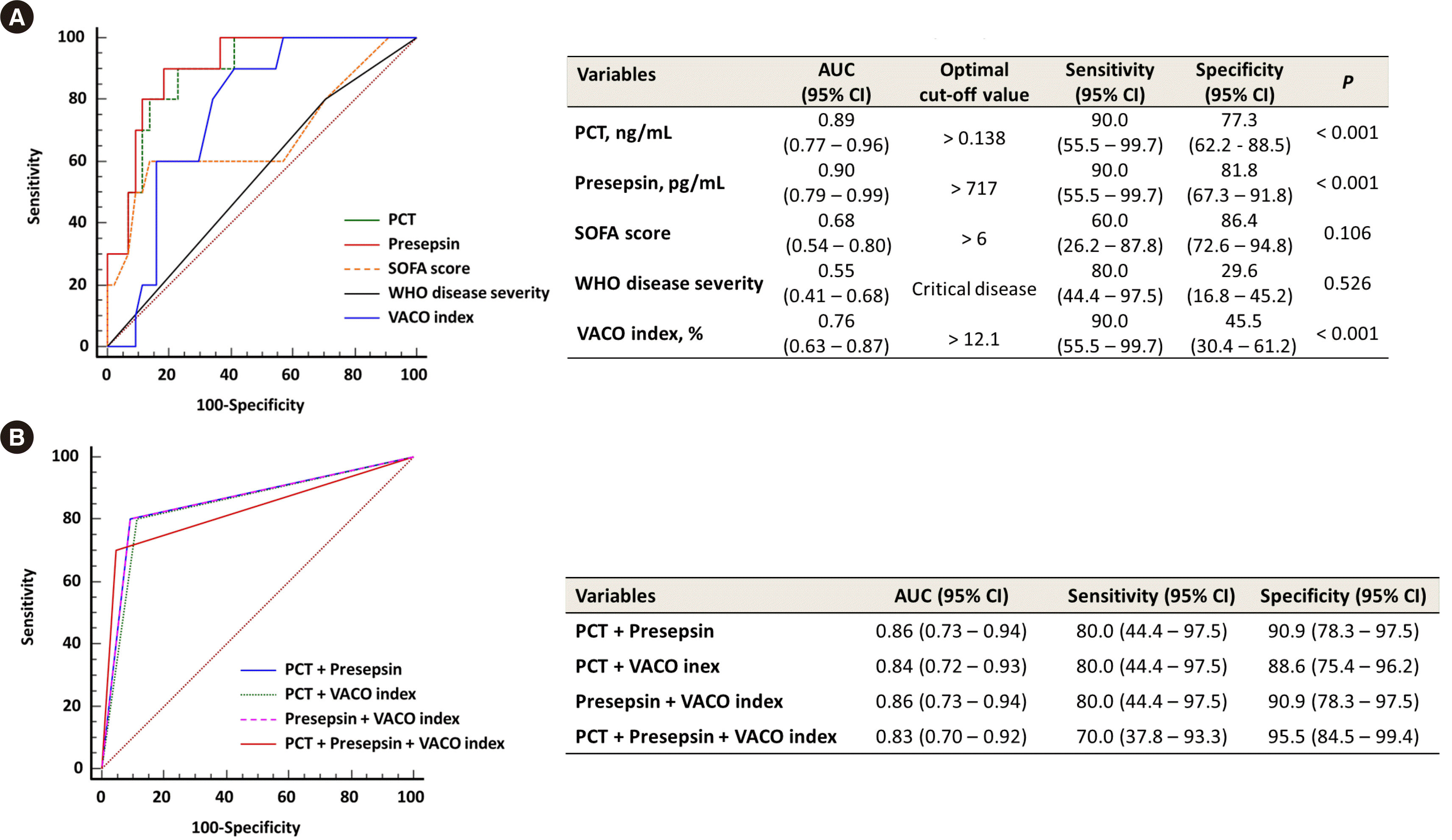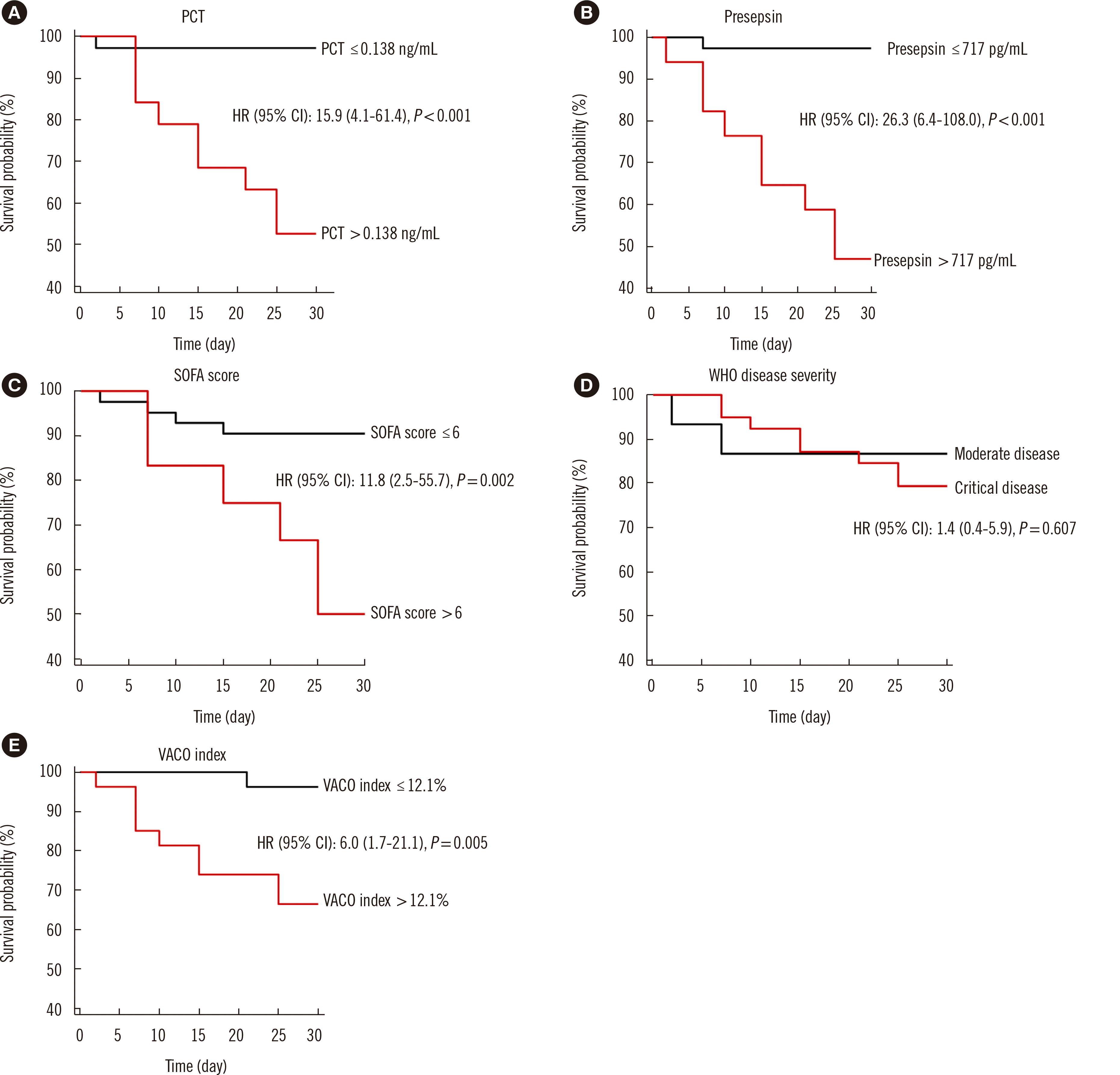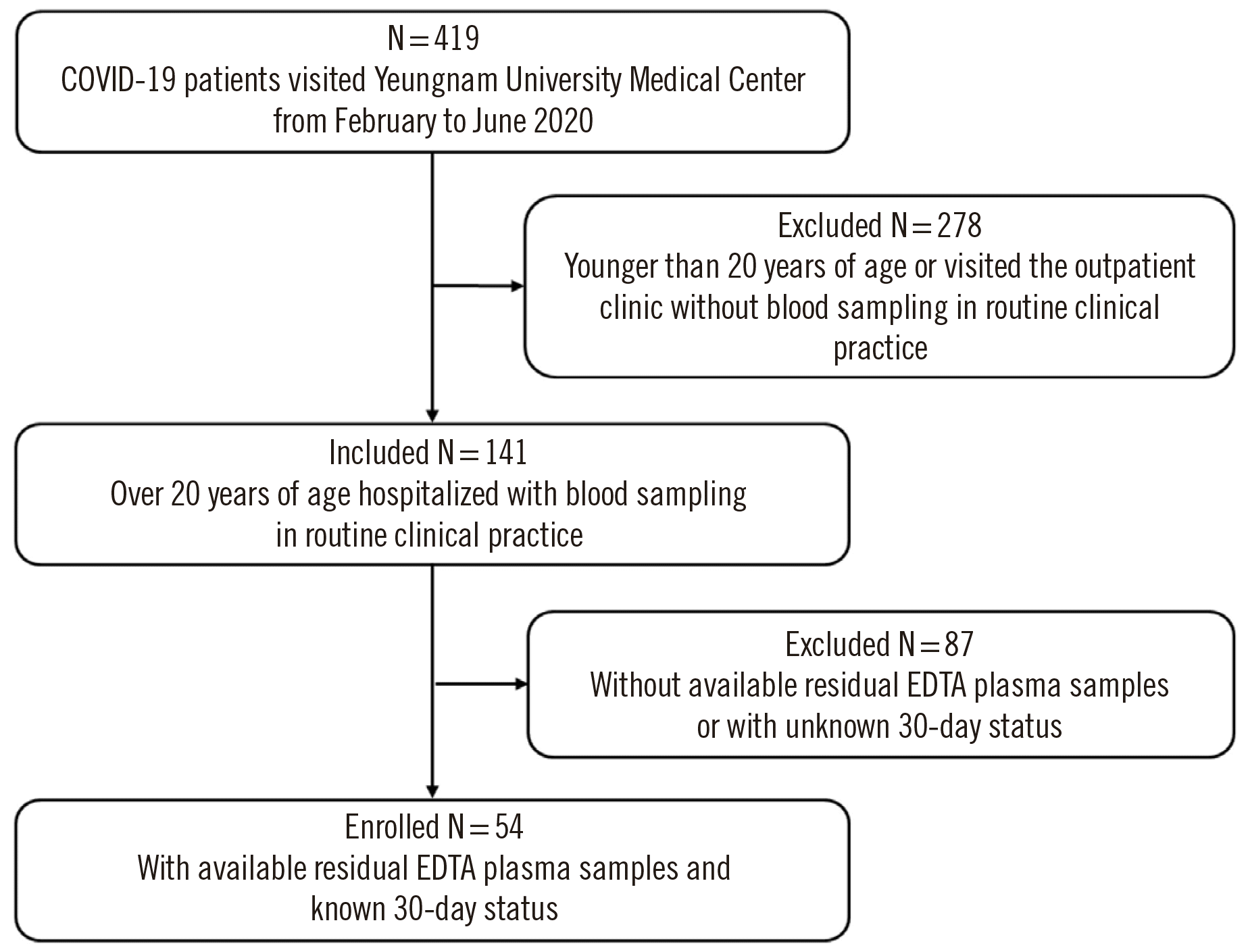INTRODUCTION
MATERIALS AND METHODS
Study population
PCT and presepsin assays
VACO index
Statistical analysis
RESULTS
Table 1
| Variable | All patients (N=54) |
|---|---|
| Age (yr) | 71.0 (63.0-79.0) |
| Male, N (%) | 31 (57.4) |
| Comorbidities, N (%) | |
| Hypertension | 28 (51.9) |
| Diabetes mellitus | 19 (35.2) |
| Dyslipidemia | 9 (17.0) |
| Malignancy | 7 (13.0) |
| Neurodegenerative | 7 (13.0) |
| Cerebrovascular disease | 5 (9.3) |
| Cardiovascular disease | 5 (9.3) |
| Heart failure | 4 (7.4) |
| Pulmonary disease | 3 (5.6) |
| Psychiatric disorders | 3 (5.6) |
| Chronic kidney disease | 2 (3.7) |
| Peripheral artery disease | 2 (3.7) |
| Liver disease | 2 (3.7) |
| Rheumatic arthritis | 1 (1.9) |
| Symptoms, N (%) | |
| Fever ( ≥ 37.5°C) | 35 (64.8) |
| Dyspnea | 29 (53.7) |
| General weakness | 24 (44.4) |
| Cough | 21 (38.9) |
| Sputum | 14 (25.9) |
| Fatigue | 11 (20.4) |
| Gastrointestinal symptoms* | 8 (14.8) |
| Chilling | 6 (11.1) |
| Myalgia | 6 (11.1) |
| Headache | 5 (9.3) |
| Sore throat | 4 (7.4) |
| Hemoptysis | 1 (1.9) |
| Rhinorrhea | 1 (1.9) |
| Nasal obstruction | 1 (1.9) |
| Chest pain | 1 (1.9) |
| Dizziness | 1 (1.9) |
| Mental change | 1 (1.9) |
| Limb muscle weakness | 1 (1.9) |
| Symptom duration (day) | 4.0 (0.0-8.0) |
| COVID-19 diagnosis to admission (day) | 0.0 (0.0-3.0) |
| COVID-19 diagnosis to blood sampling (day) | 4.0 (0.0-9.0) |
| Vital signs | |
| Systolic blood pressure (mmHg) | 126.5 (110.0-145.0) |
| Diastolic blood pressure (mmHg) | 75.0 (70.0-81.0) |
| Heart rate (frequency/min) | 83.0 (76.0-92.0) |
| Respiratory rate (frequency/min) | 20.0 (20.0-23.0) |
| Body temperature (°C) | 37.2 (36.9-37.8) |
| O2 saturation (%) | 96.0 (94.0-97.9) |
| Clinical data | |
| Use of ventilator, N (%) | 12 (22.2) |
| Use of ECMO, N (%) | 5 (9.3) |
| Hospital stay (day) | 28.0 (18.0-41.0) |
| In-hospital mortality, N (%) | 14 (25.9) |
| 30-day mortality, N (%) | 10 (18.5) |
| Laboratory data | |
| WBC ( × 109/L) | 6.3 (5.0-7.7) |
| ANC ( × 109/L) | 4.6 (3.2-6.1) |
| Lymphocyte ( × 109/L ) | 1.0 (0.7-1.5) |
| N/L ratio | 4.1 (2.5-8.6) |
| Hb (g/L) | 117.0 (109.0-130.0) |
| Hct (%) | 35.0 (32.8-37.9) |
| P LT ( × 109/L) | 219.0 (157.0-306.0) |
| AST (IU/L) | 30.0 (24.0-42.0) |
| ALT (IU/L) | 25.0 (15.0-43.3) |
| ALP (IU/L) | 72.0 (63.0-85.0) |
| Total bilirubin (umol/L) | 11.9 (8.6-17.1) |
| Direct bilirubin (umol/L) | 3.4 (1.7-6.8) |
| LDH (U/L) | 516.0 (421.0-677.0) |
| BUN (mmol/L) | 5.7 (3.6-8.6) |
| Cr (µmol/L) | 70.7 (53.0-97.2) |
| Lactate (mmol/L) | 2.0 (1.3-2.4) |
| CRP (mg/L) | 31.0 (5.0-125.0) |
| Blood culture positive†, N (%) | 1 (1.9) |
| PCT (ng/mL) | 0.09 (0.04-0.31) |
| Presepsin (pg/mL) | 367.0 (182.0-859.0) |
| Severity assessment | |
| SOFA score | 3.0 (1.0-6.0) |
| SOFA score ≥ 2, N (%) | 39 (72.2) |
| SOFA score: range | 0-14 |
| 0 (4, 7.4%); 1 (11, 20.3%); 2 (8, 14.8%); 3 (8, 14.8%); 4 (7, 13.0%); 5 (2, 3.7%); 6 (2, 3.7%); 7 (2, 3.7%); 8 (1, 1.9%); 9 (3, 5.6%); 11 (4, 5.6%); 12 (2, 1.9%); 14 (2, 3.7%) | |
| WHO disease severity, N (%) | |
| Mild disease | 0 (0.0) |
| Moderate disease (pneumonia) | 15 (27.8) |
| Severe disease (severe pneumonia) | 0 (0.0) |
| Critical disease | 39 (72.2) |
| ARDS‡ | 10 (18.5) |
| Sepsis | 32 (82.1) |
| Septic shock | 6 (15.3) |
| Acute thrombosis§ | 1 (11.1) |
| VACO index (%) | 12.1 (5.3-18.0) |
*Gastrointestinal symptoms include anorexia, nausea, abdominal pain, abdominal distension, or diarrhea; †Blood culture results were obtained from 35 patients at enrollment; ‡ARDS with sepsis (N=6) and ARDS with septic shock (N=4); §One COVID-19 patient presenting with limb muscle weakness was diagnosed as having acute stroke with sepsis at enrollment.
Abbreviations: COVID-19, coronavirus disease; ECMO, extracorporeal membrane oxygenation; WBC, white blood cell; ANC, absolute neutrophil count; N/L ratio, neutrophil:lymphocyte ratio; Hb, hemoglobin; Hct, hematocrit; PLT, platelets; AST, aspartate aminotransferase; ALT, alanine aminotransferase; ALP, alkaline phosphatase; LDH, lactate dehydrogenase; BUN, blood urea nitrogen; Cr, creatinine; CRP, C-reactive protein; PCT, procalcitonin; SOFA, sequential organ failure assessment; ARDS, acute respiratory distress syndrome; VACO, Veterans Health Administration COVID-19.
Table 2
 | Fig. 2ROC curve analysis of PCT, presepsin, the SOFA score, WHO disease severity, the VACO index, and multimarker approaches for predicting 30-day mortality. (A) PCT, presepsin, the SOFA score, WHO disease severity, and the VACO index. (B) Multimarker approaches using the above optimal cut-off values of PCT, presepsin, and the VACO index. Abbreviations: PCT, procalcitonin; SOFA, sequential organ failure assessment; VACO, Veterans Health Administration COVID-19; AUC, area under the ROC curve; CI, confidence interval. |
 | Fig. 3Kaplan–Meier survival curves of PCT, presepsin, the SOFA score, WHO disease severity, and the VACO index for predicting 30-day mortality. (A) PCT. (B) Presepsin. (C) SOFA score. (D) WHO disease severity. (E) VACO index. Abbreviations: PCT, procalcitonin; SOFA, sequential organ failure assessment; VACO, Veterans Health Administration COVID-19; HR, hazard ratio; CI, confidence interval. |




 PDF
PDF Citation
Citation Print
Print




 XML Download
XML Download